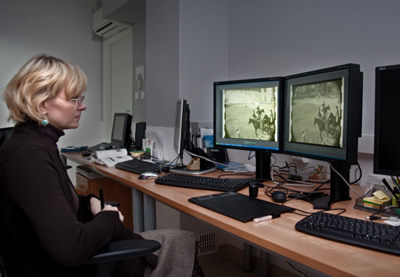
The main function of film reconstruction software is to minimize damage to an archival material. Software algorithms analyze individual shots, compare information from successive frames, pixel by pixel. This makes it possible to detect dirt and damage to the film and to trace movements of objects and the camera. Computers that carry out these complex calculations are multiprocessor working stations with immense computing power and hard drive space. On the basis of a digital analysis, the software can stabilize the image, reduce flicker and remove single or multi-frame deformations. The software can generate a complete frame on the basis of the neighbouring frames by analyzing image, movements of the camera and objects (then it creates an intermediate stage, reproducing a similar grain texture in a given frame).
 fot. Krzysztof Szymański |
Similarly, by analyzing the image from frame to frame, the software detects any clinging or transferred particles of dust or stains other than image components and removes them. This automatic process must nonetheless be strictly supervised by the operator to avoid accidental removal of tiny moving elements.
Another range of problems is associated with multi-frame flaws, e.g. scratches. They are caused by dirt which clings to the tape-guide mechanism (in a projector, copier or screening table), resulting in scratches of different depth on several frames or even the entire film roll. Such an image fragment cannot be overwritten on the basis of the previous or the next frames, as the same flaw occurs everywhere. To mask the existing defects, the software carries out more complex calculations and a pixel-by-pixel analysis of the area adjacent to the scratch.















